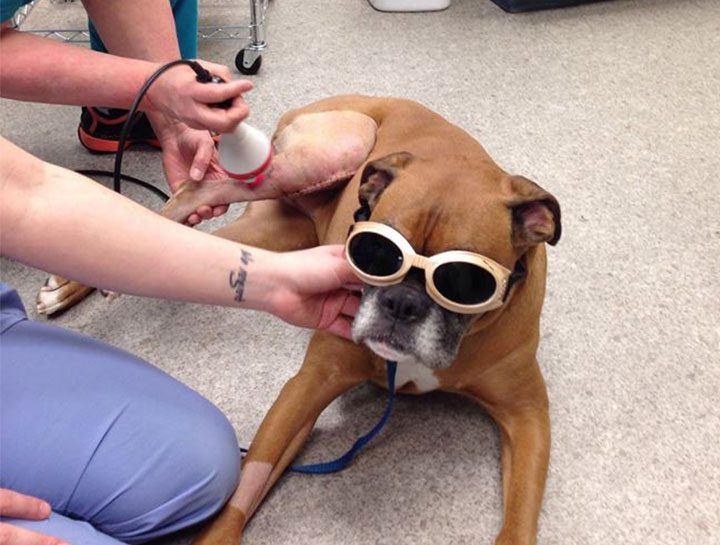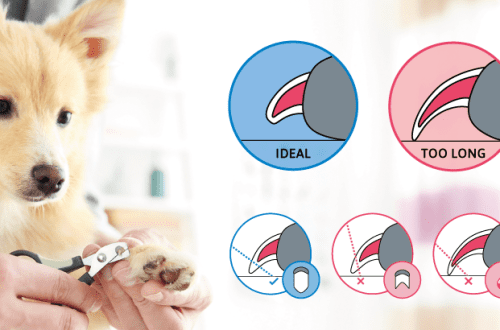
Laser Therapy for Dogs: When It Can Help
Laser therapy, sometimes referred to as cold laser therapy, has been available to treat people for decades. And only in recent years it has begun to be used for dogs. But what is it and is it safe for a pet? When can laser therapy for dogs be effective?
Contents
Laser therapy for dogs
Laser therapy is a procedure that uses a laser to speed up tissue healing by stimulating cell regeneration and increasing blood flow, explains the American Kennel Club Canine Health Foundation (AKCCHF). The word “laser” is actually an acronym that stands for “light amplification by stimulated emission.” This means that the laser is a concentrated beam of photon radiation in the form of light, according to Innovative Veterinary Care (IVC).
This type of laser therapy is sometimes referred to as cold laser therapy to distinguish it from surgical lasers, which use much higher frequencies to penetrate deeper tissues. Laser therapy is non-invasive, that is, the doctor will not make surgical accesses – incisions. . Instead, veterinarians simply aim a low-frequency laser beam at the surface of the skin and coat to treat the tissue below the surface.
How laser treatment for dogs works
Laser therapy promotes tissue healing and pain relief through a process called photobiomodulation. Photobiomodulation is a photochemical process in which light interacts with cells, causing biochemical reactions. Among them are improving blood circulation at the cellular level, stimulating the immune system, reducing inflammation, activating collagen production and developing muscle tissue. All these reactions contribute to the restoration of damaged tissues.

Diseases for which laser treatment of dogs is used
Canine laser therapy is primarily used to treat the following conditions:
- acute and chronic injuries;
- stretching of ligaments or muscles;
- osteoarthritis and joint pain;
- herniated disc;
- problems with the musculoskeletal system;
- postoperative restoration of nervous tissue.
Laser Therapy Safety
Cold laser therapy is a safe procedure. The frequency of light energy used does not create a risk of burns for the pet. The most significant danger is the possibility of damage to the retina when looking directly into the laser beam. To avoid such problems, the laser operator wears safety goggles. As for the dog, during the procedure, they either put on goggles, or cover their eyes with a bandage, or turn away from the beam.
How do dogs perceive laser therapy?
This treatment method is characterized by a low level of stress. In fact, experts note that many dogs find it relaxing and enjoyable. During the procedure, the pet is usually allowed to stand or lie down, or the owner holds him in his arms, whichever is more convenient for him.
The procedure can take anywhere from two to twenty minutes, depending on the severity of the tissue damage. In this case, sedation or shaving of the affected area is not required. In many cases, dogs not only feel better immediately after the procedure, but also experience a rush of endorphins. They cause positive associations with laser treatment sessions in pets..
Side effects and recovery
Laser therapy has no reported side effects. The dog does not need time to recover. While some pets require a full course to be effective, many show signs of reduced pain and discomfort, as well as increased mobility and activity after just one or two sessions.
Price and availability
Prices for laser therapy vary from region to region, so you should contact your veterinarian to find out the cost of a session. As a general rule, you should start with two to three sessions per week, depending on the type and severity of the problem, gradually decreasing to once a week and then to once every two weeks.
Unfortunately, the laser equipment used is very expensive, so laser therapy for dogs has not yet become widespread. However, as the popularity of this treatment among veterinarians and dog owners grows, it can be expected that the price of the equipment will decrease and this will make it available to more veterinary clinics. If the veterinarian does not perform laser therapy, he will be able to refer you to a clinic offering this type of service. To find out if these procedures are suitable for a particular dog, a consultation with a specialist is necessary.
Although laser therapy for dogs is a fairly new type of treatment, in medical applications it has already stood the test of time. It is hoped that many more dogs will be able to benefit from this method, characterized by low levels of stress and already recognized as safe and effective.





